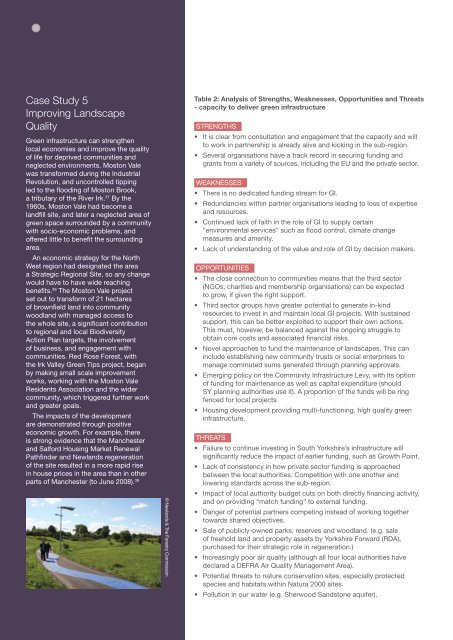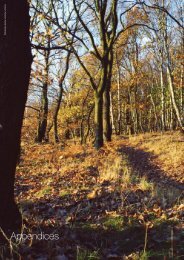4. Valuing Green Infrastructure - South Yorkshire Forest Partnership
4. Valuing Green Infrastructure - South Yorkshire Forest Partnership
4. Valuing Green Infrastructure - South Yorkshire Forest Partnership
Create successful ePaper yourself
Turn your PDF publications into a flip-book with our unique Google optimized e-Paper software.
22<br />
Case Study 5<br />
Improving Landscape<br />
Quality STRENGTHS<br />
<strong>Green</strong> infrastructure can strengthen<br />
local economies and improve the quality<br />
of life for deprived communities and<br />
neglected environments. Moston Vale<br />
was transformed during the Industrial<br />
Revolution, and uncontrolled tipping<br />
led to the flooding of Moston Brook,<br />
a tributary of the River Irk. 37 By the<br />
1960s, Moston Vale had become a<br />
landfill site, and later a neglected area of<br />
green space surrounded by a community<br />
with socio-economic problems, and<br />
offered little to benefit the surrounding<br />
area.<br />
An economic strategy for the North<br />
West region had designated the area<br />
a Strategic Regional Site, so any change<br />
would have to have wide reaching<br />
benefits. 38 The Moston Vale project<br />
set out to transform of 21 hectares<br />
of brownfield land into community<br />
woodland with managed access to<br />
the whole site, a significant contribution<br />
to regional and local Biodiversity<br />
Action Plan targets, the involvement<br />
of business, and engagement with<br />
communities. Red Rose <strong>Forest</strong>, with<br />
the Irk Valley <strong>Green</strong> Tips project, began<br />
by making small scale improvement<br />
works, working with the Moston Vale<br />
Residents Association and the wider<br />
community, which triggered further work<br />
and greater goals.<br />
The impacts of the development<br />
are demonstrated through positive<br />
economic growth. For example, there<br />
is strong evidence that the Manchester<br />
and Salford Housing Market Renewal<br />
Pathfinder and Newlands regeneration<br />
of the site resulted in a more rapid rise<br />
in house prices in the area than in other<br />
parts of Manchester (to June 2008). 39<br />
© Newlands & The <strong>Forest</strong>ry Commission<br />
Table 2: Analysis of Strengths, Weaknesses, Opportunities and Threats<br />
- capacity to deliver green infrastructure<br />
• It is clear from consultation and engagement that the capacity and will<br />
to work in partnership is already alive and kicking in the sub-region.<br />
• Several organisations have a track record in securing funding and<br />
grants from a variety of sources, including the EU and the private sector.<br />
WEAKNESSES<br />
• There is no dedicated funding stream for GI.<br />
• Redundancies within partner organisations leading to loss of expertise<br />
and resources.<br />
• Continued lack of faith in the role of GI to supply certain<br />
“environmental services” such as flood control, climate change<br />
measures and amenity.<br />
• Lack of understanding of the value and role of GI by decision makers.<br />
OPPORTUNITIES<br />
• The close connection to communities means that the third sector<br />
(NGOs, charities and membership organisations) can be expected<br />
to grow, if given the right support.<br />
• Third sector groups have greater potential to generate in-kind<br />
resources to invest in and maintain local GI projects. With sustained<br />
support, this can be better exploited to support their own actions.<br />
This must, however, be balanced against the ongoing struggle to<br />
obtain core costs and associated financial risks.<br />
• Novel approaches to fund the maintenance of landscapes. This can<br />
include establishing new community trusts or social enterprises to<br />
manage commuted sums generated through planning approvals.<br />
• Emerging policy on the Community <strong>Infrastructure</strong> Levy, with its option<br />
of funding for maintenance as well as capital expenditure (should<br />
SY planning authorities use it). A proportion of the funds will be ring<br />
fenced for local projects.<br />
• Housing development providing multi-functioning, high quality green<br />
infrastructure.<br />
THREATS<br />
• Failure to continue investing in <strong>South</strong> <strong>Yorkshire</strong>’s infrastructure will<br />
significantly reduce the impact of earlier funding, such as Growth Point.<br />
• Lack of consistency in how private sector funding is approached<br />
between the local authorities. Competition with one another and<br />
lowering standards across the sub-region.<br />
• Impact of local authority budget cuts on both directly financing activity,<br />
and on providing “match funding” to external funding.<br />
• Danger of potential partners competing instead of working together<br />
towards shared objectives.<br />
• Sale of publicly-owned parks, reserves and woodland. (e.g. sale<br />
of freehold land and property assets by <strong>Yorkshire</strong> Forward (RDA),<br />
purchased for their strategic role in regeneration.)<br />
• Increasingly poor air quality (although all four local authorities have<br />
declared a DEFRA Air Quality Management Area).<br />
• Potential threats to nature conservation sites, especially protected<br />
species and habitats within Natura 2000 sites.<br />
• Pollution in our water (e.g. Sherwood Sandstone aquifer).




